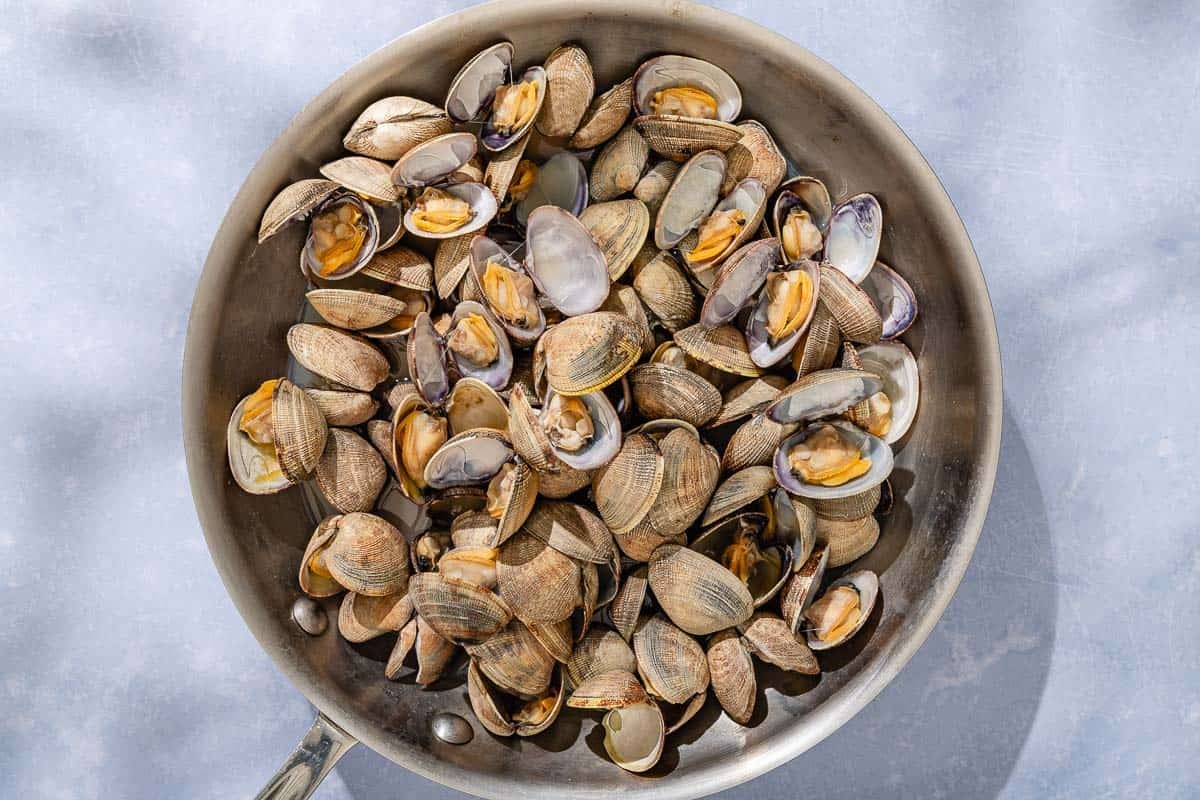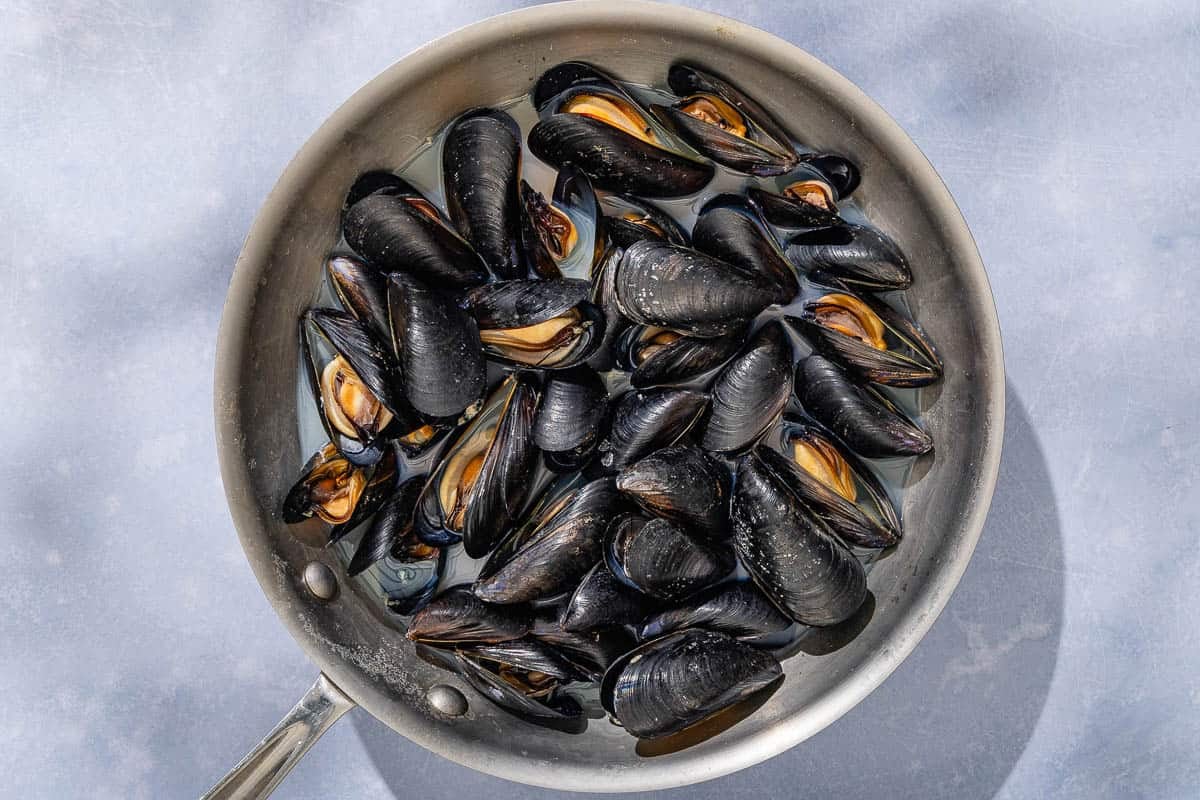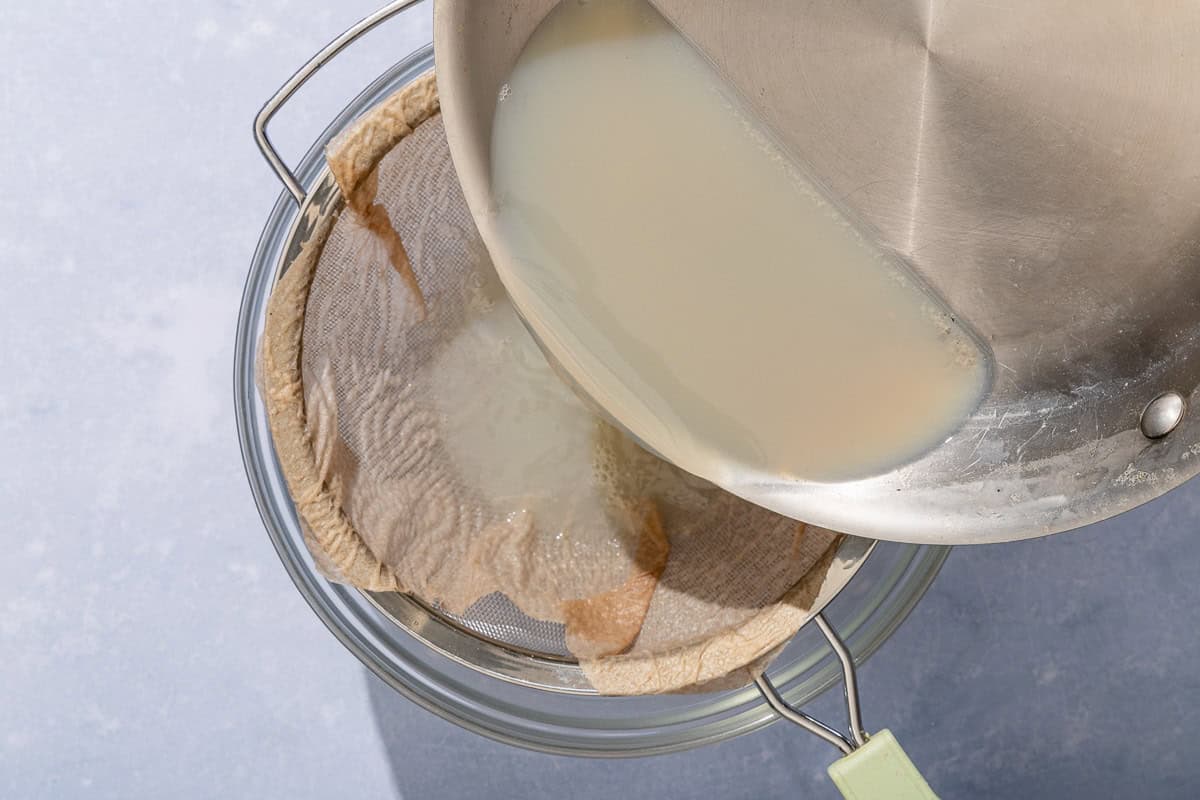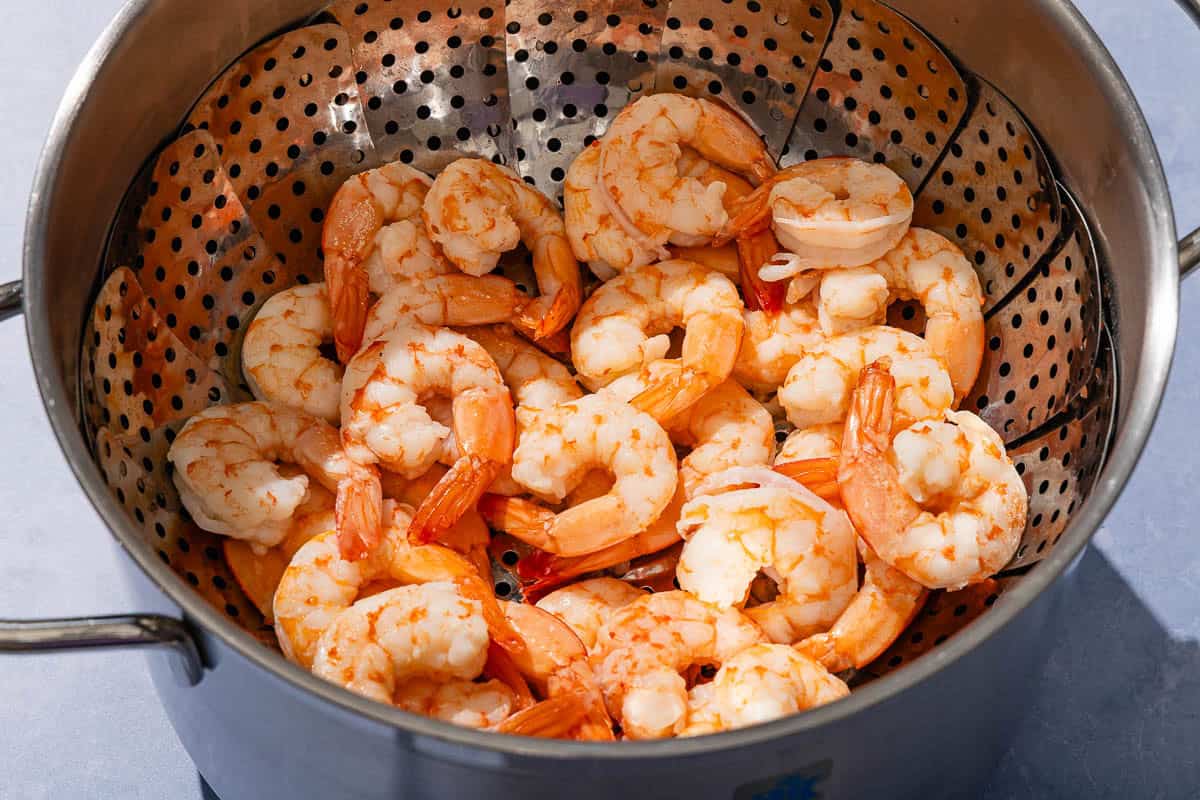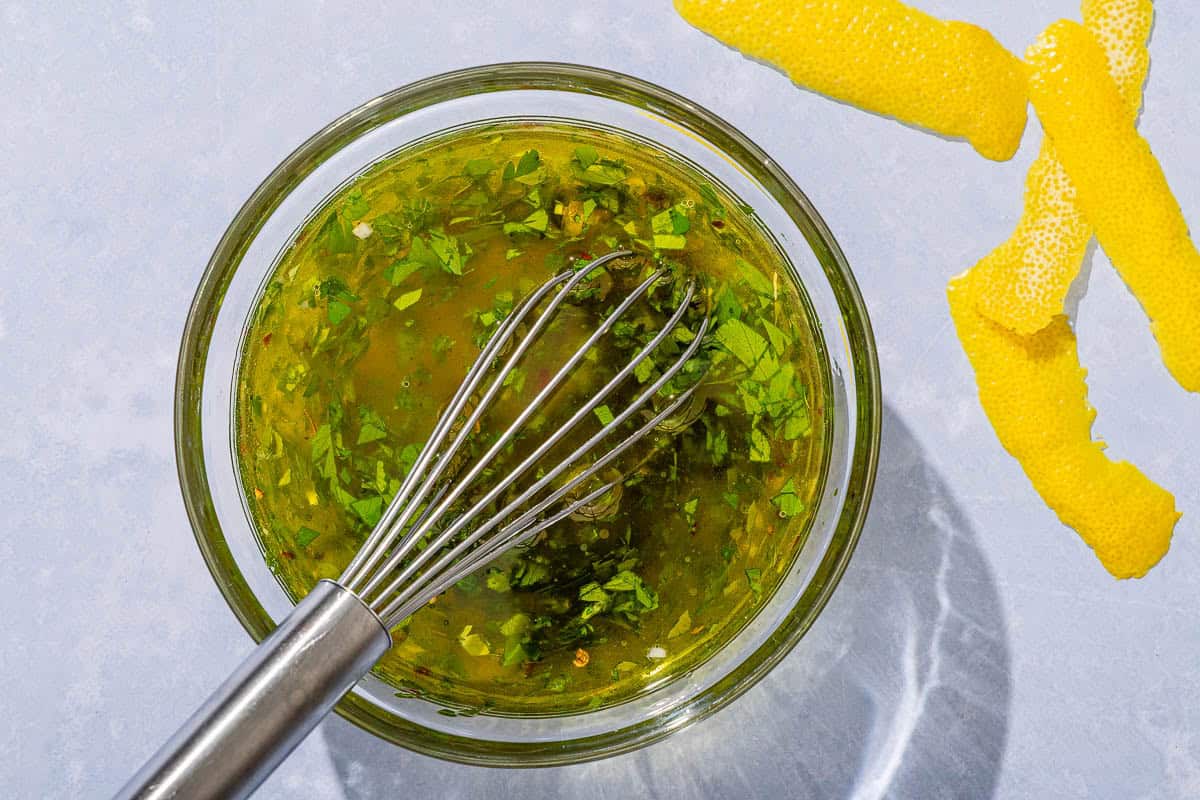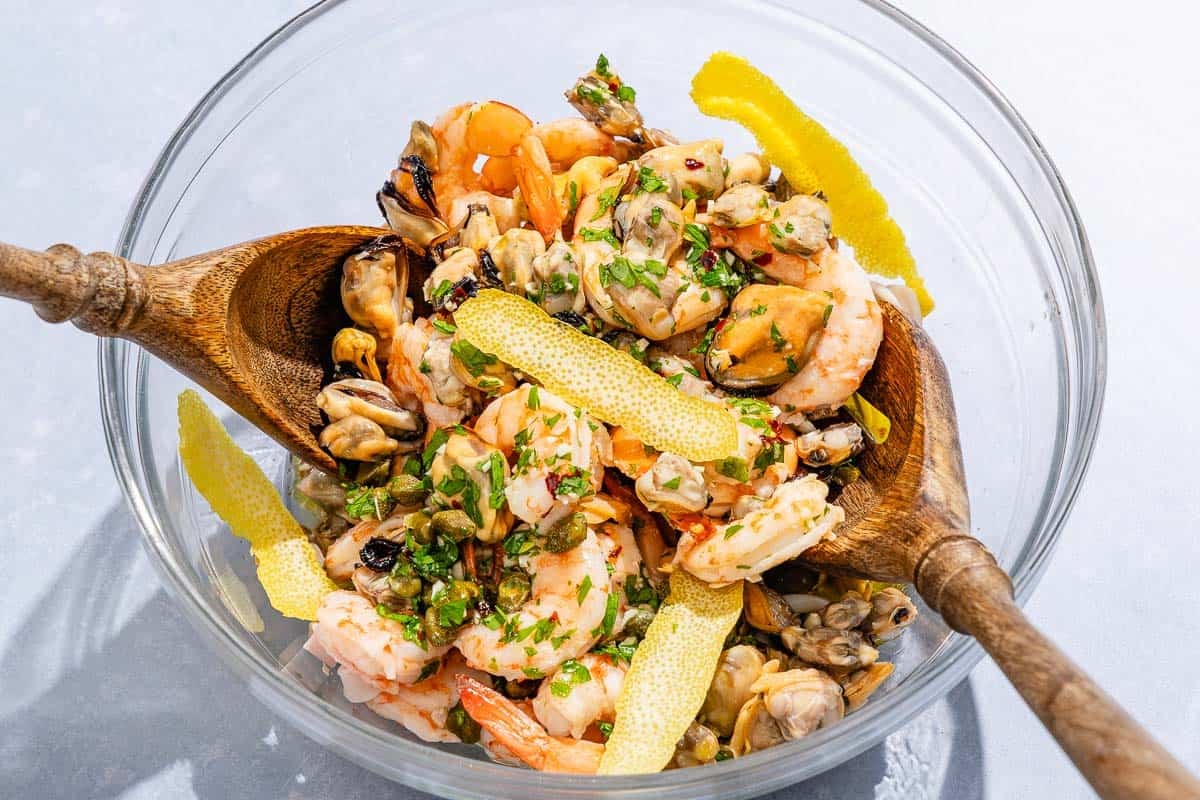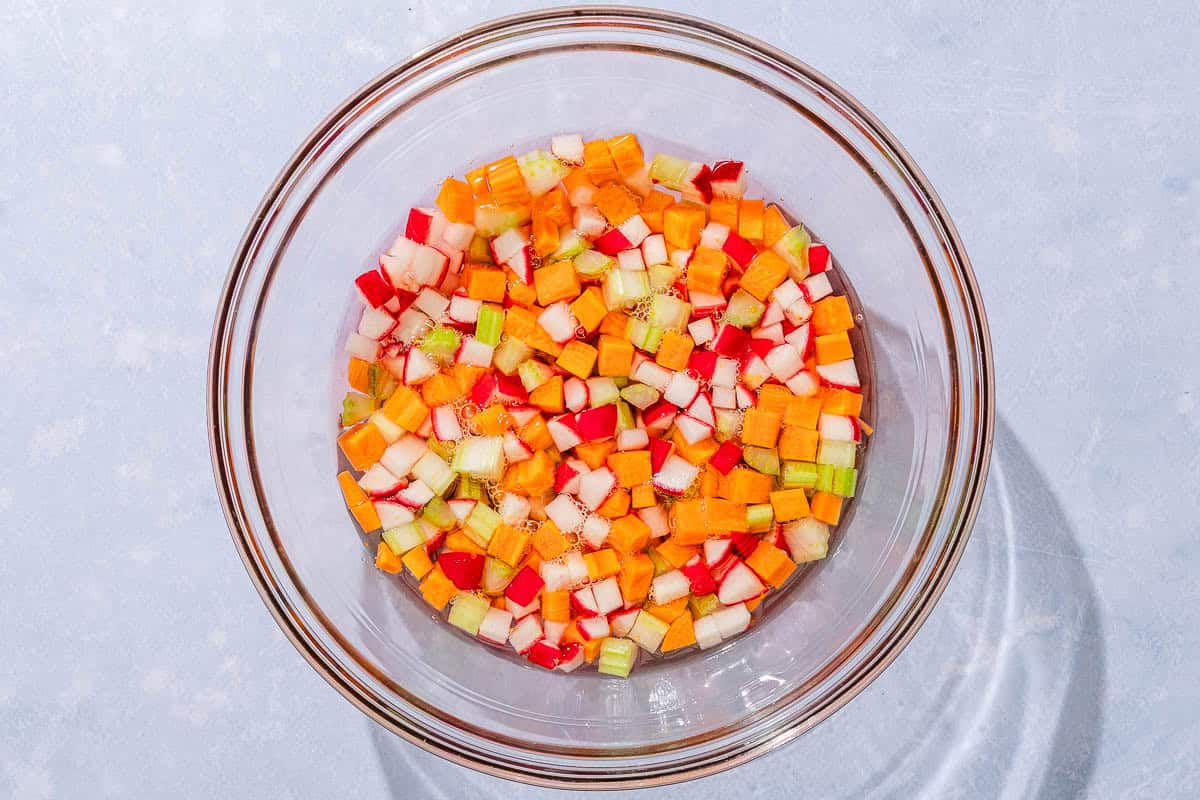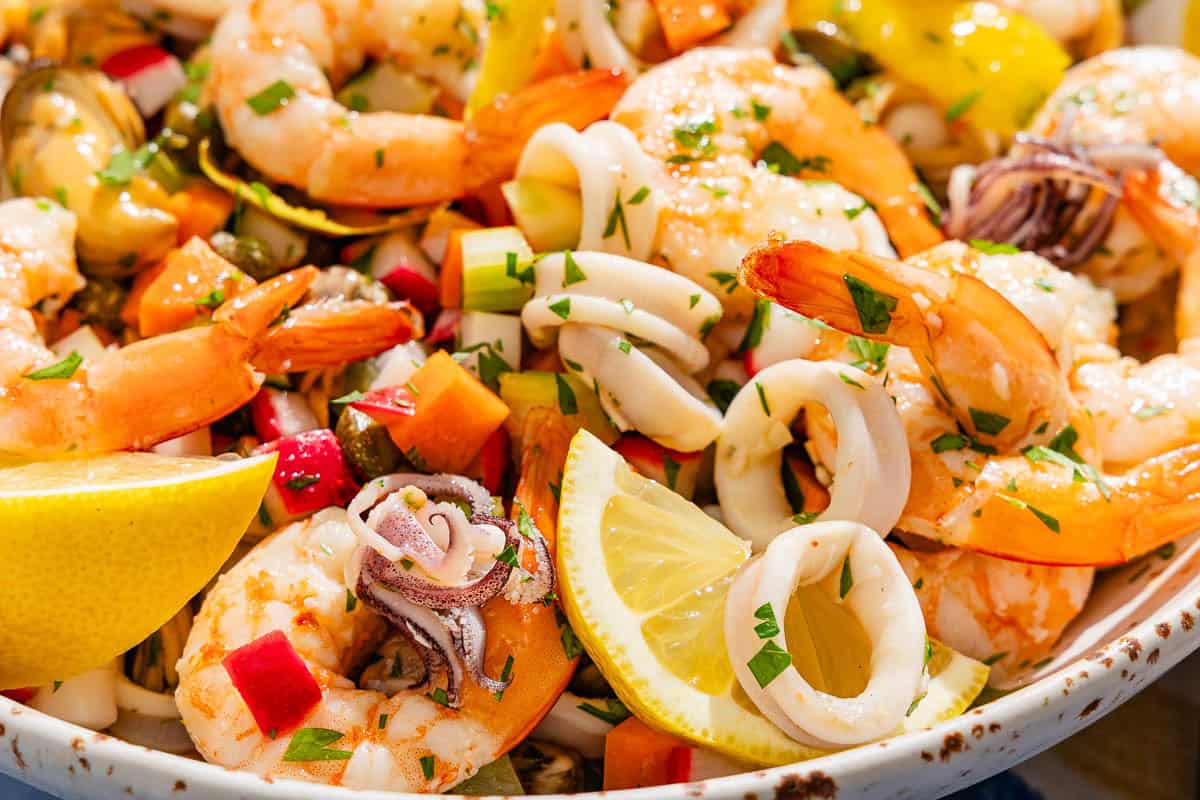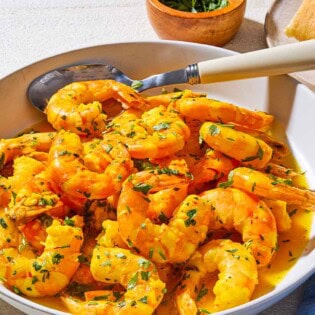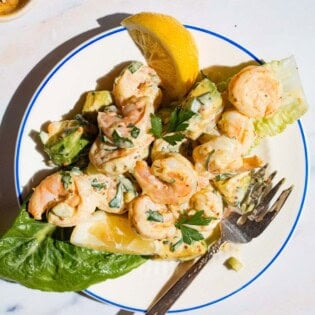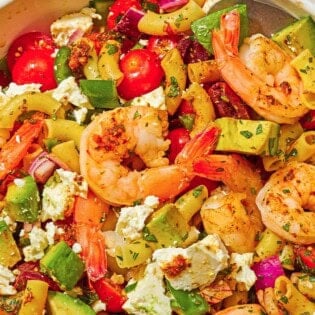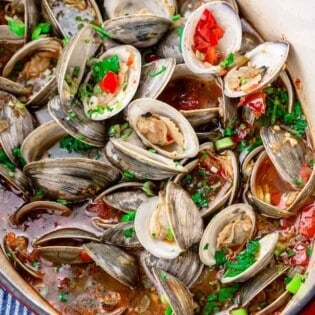Bright, lemony, and packed with fresh seafood, Insalata di Mare is a classic Italian seafood salad. Tossed with crunchy, quick-pickled vegetables, it makes a light and delicious antipasto or first course for an outdoor dinner party, or even a summer entree.
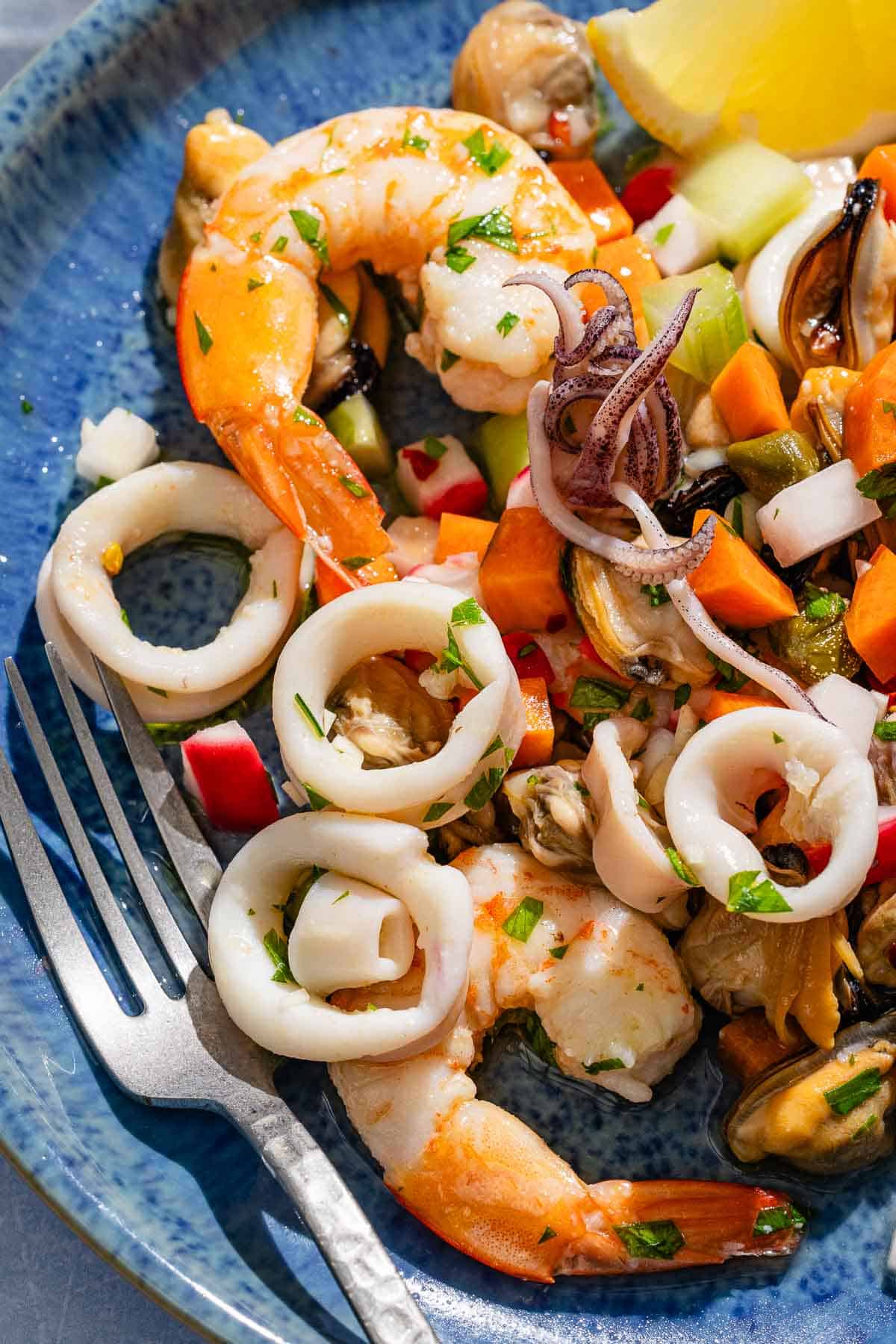
I have many fond memories of childhood summers spent at the beach on Italy’s Adriatic Coast. Among my favorite are the celebratory seafood feasts that would take place once or twice a summer. A big group of family and friends would gather around a long table at one of the local restaurants and spend the afternoon eating course after course of freshly caught fish, accompanied by cold glasses of wine and animated conversations.
Among the courses, there was always Insalata di Mare, a seafood salad of shrimp, calamari, tiny clams, and mussels marinated in a tangy garlic and lemon dressing. Bright and refreshing, it was a welcome counterpoint to the richer fried and roasted fish courses.
Making Insalata di Mare at home brings back all those great memories and flavors. For my homemade version, I toss the marinated seafood with diced celery and a quick pickle of sliced carrots and radishes, which punches up the flavor even more and adds a welcome crunch to the salad.
I won’t lie—this recipe takes a bit of work, between cleaning and prepping, then cooking the seafood, but it’s worth it. The great news is that none of these steps is difficult, and it’s a great make-ahead recipe. In fact, this salad gets better if it’s allowed to chill for several hours. This gives all the ingredients and flavors a chance to meld.
Table of Contents
- What is Insalata di Mare?
- What’s in Italian Seafood Salad?
- How to Prep the Seafood
- Scrub and purge the clams:
- De-beard and scrub the mussels:
- Peel and devein the shrimp:
- Rinse and slice the calamari:
- How to Make Italian Seafood Salad
- Make it Your Own
- What to Serve with Italian Seafood Salad
- More Mediterranean Shellfish Recipes
- Italian Seafood Salad (Insalada di Mare) Recipe
What is Insalata di Mare?
Simply put, “insalata di mare” translates to “salad of the sea.” There are many different versions of this seafood salad, featuring the small fish and seafood from Italy’s Mediterranean and Adriatic coasts. But the most common ingredients are shrimp, squid or cuttlefish, mussels, and tiny clams known as vongole veraci.
The salad is typically marinated with lemon, garlic, parsley, and olive oil and served as a cold antipasto as part of a multi-course seafood lunch or dinner. While insalata di mare’s bright flavors are especially refreshing in summer, Italians enjoy this salad year-round, including Christmas Eve, where it is part of the traditional holiday seafood feast.
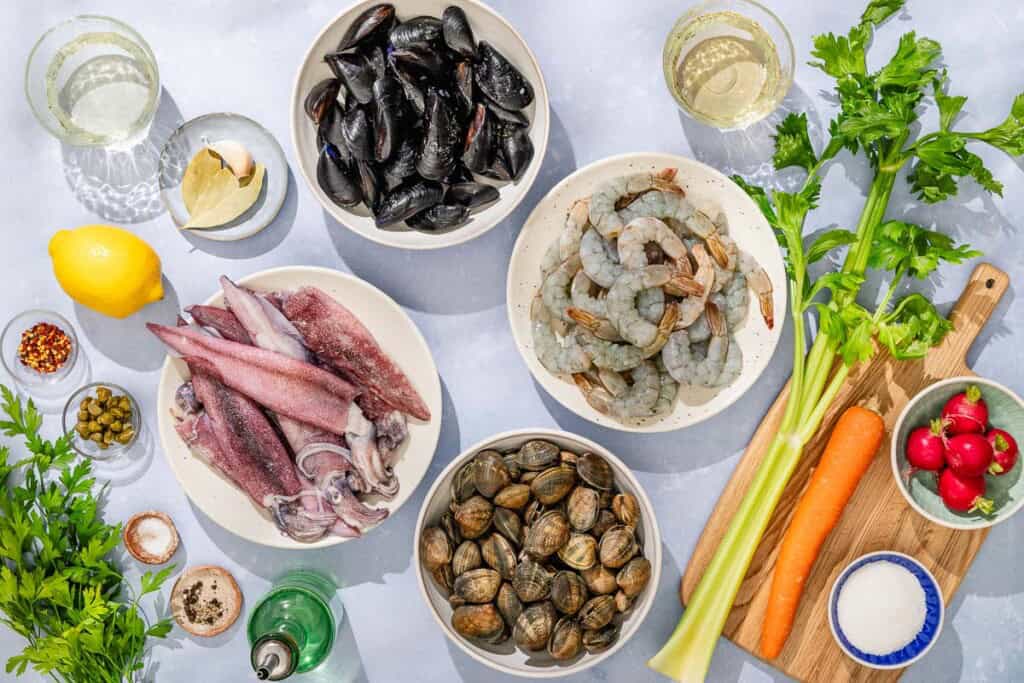
What’s in Italian Seafood Salad?
You might be surprised to learn that there are no unusual or difficult-to-find ingredients in this seafood salad. Even calamari are now sold at many supermarket seafood counters, and they are usually already cleaned. Here’s what you’ll need for this recipe.
- Fresh clams: You’ll need 2 pounds (about 2 dozen) small whole clams in their shells. Look for varieties such as Manila, which are small, meaty, and sweet. Littleneck clams, which are slightly larger, are more readily available, also work. Make sure you buy clams that are fresh and alive—they should be tightly closed in their shells with no “off” odors.
- Fresh mussels: With their plump orange flesh and sweet briny flavor, mussels are a great addition to this salad. As with clams, make sure the mussels you buy are fresh, alive, tightly closed, and smelling of brine and the sea. Mussels and clams have slightly different cooking times, so I steam them separately. This prevents them from being either overcooked or undercooked.
- Shrimp: I prefer to steam rather than poach shrimp for this seafood salad, as it helps to preserve the texture and flavor. Medium to large shrimp are best for this salad. Look for fresh (or frozen) shrimp still in their shells rather than those that have already been peeled and deveined—the shell preserves the shrimp’s moisture and freshness. More on this in our guide to buying and cooking shrimp.
- Calamari: Calamari is the Italian word for squid, a popular seafood in many world cuisines. Most supermarkets now carry cleaned squid—both the long, pearly white oval bodies (sacs) and the curly purple tentacles. Be sure to get some of both for your seafood salad.
- White wine: I steam open clams and mussels in a skillet with just a splash of dry white wine to help flavor the juices given off by the bivalves. Choose an inexpensive but still drinkable dry white, such as Pinot Grigio. If you don’t want to use wine, you can use water, seafood stock, or vegetable broth.
- Aromatics: Lemon, both zest and juice, along with garlic, parsley, and a generous pinch of crushed red pepper, are the dressing components that give this salad its bright, punchy flavors. A spoonful of tiny capers adds an earthy, briny note.
- Bay leaf: I add a bay leaf to the calamari poaching liquid for a savory touch, and I tuck a second bay leaf into the salad when I set it in the refrigerator to marinate.
- Extra virgin olive oil: Good oil forms the foundation for the lemony dressing for this salad. Choose a good Italian olive oil that is fresh, with rich, buttery notes, like our Nocellara.
- Pickled Vegetables: It’s an extra step, but I like to take the time to cut up a carrot, a stalk of celery, and a small handful of radishes into small pieces and marinate them in a brine of cider vinegar, water, sugar, and salt. Tossed with the salad shortly before serving, the pickled vegetables add color, crunch, and an extra zing of flavor.
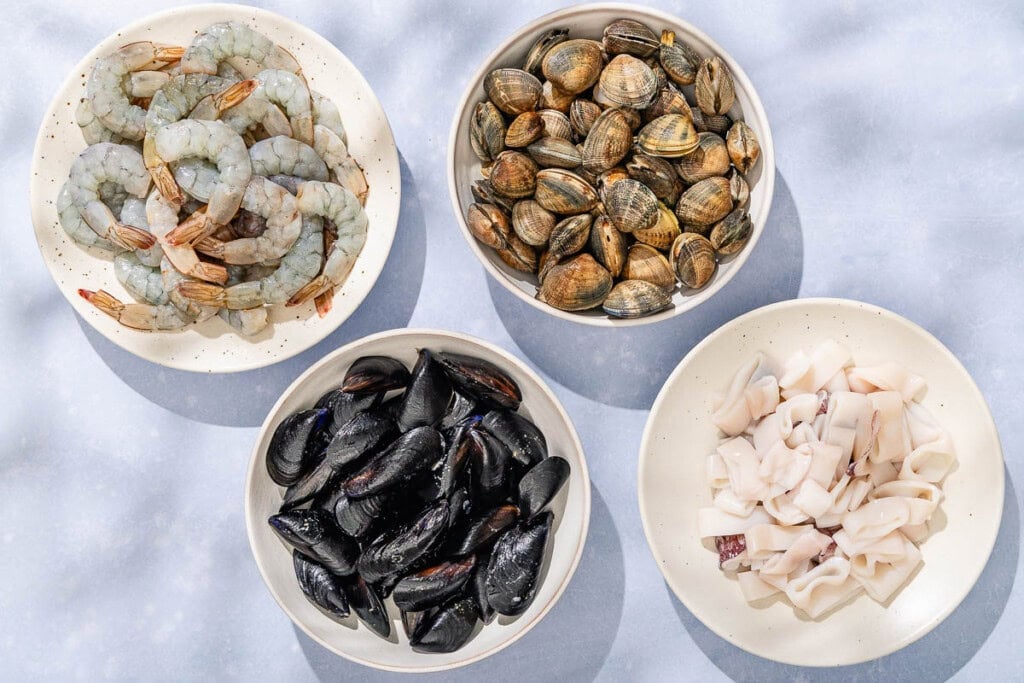
How to Prep the Seafood
This recipe involves numerous steps, but none are difficult. I break it up into two parts: cleaning and cooking the seafood, and making the salad. Once you have cleaned and cooked the seafood, the salad comes together easily.
Scrub and purge the clams:
- Check the clams. Make sure there are no open clams. Discard any that do not close when lightly tapped.
- Scrub the clams under cold running water or in a bowl of cold water. Use a stiff brush to remove grit from the outer shells.
- Purge the clams. Pile the clams into a large bowl and cover them with cold water. Pour in a good handful of coarse salt. Let the clams sit for 15-30 minutes, giving them a gentle stir now and then. Drain them and rinse them well to remove any additional debris. Refrigerate the clams until you’re ready to cook them.
De-beard and scrub the mussels:
Cultivated mussels are generally clean and mostly devoid of grit and “beards,” those tangles of fibers you sometimes see near the hinge where the mollusk’s shells meet. But you still need to give them a good cleaning.
- Check the mussels. As with the clams, check to make sure none of the mussels are open. Discard any that do not close when lightly tapped.
- Scrub the mussels. Place the mussels in a colander and scrub them under cold running water to remove any grit.
- Remove any beards by grasping the beard with your fingers and yanking downwards towards the hinge of the shell. The fibers should come off easily. If not, just snip them off with kitchen scissors. Refrigerate the mussels until you’re ready to cook them.
Peel and devein the shrimp:
- Peel the shrimp. I use a shrimp peeler to remove the shells. It’s easy and it makes quick work of the job. Simply insert the long nose of the tool between the peel and flesh at the top of the shrimp and slide it down towards the tail. Gently lift up to separate and slice open the peel. Remove the peel and tail with your fingers. If you don’t have a shrimp peeler, use a small paring knife or kitchen scissors to cut the peel away from the shrimp flesh.
- Devein the shrimp. If there is a dark vein running along the back of the shrimp that the peeler has not removed, use your fingers or the tip of a paring knife to pull it out, and discard it. Transfer the shrimp to a clean plate or bowl as you clean them. Cover and refrigerate until you’re ready to cook them.
Rinse and slice the calamari:
- Rinse the calamari, both the sacs and the tentacles, under cold running water and pat them dry.
- Slice the calamari. Cut the sacs into 1/2-inch-wide rings. Then, cut the tentacle crowns in half to yield bite-sized pieces. Place the cut calamari in a bowl, cover, and refrigerate until you’re ready to cook them.
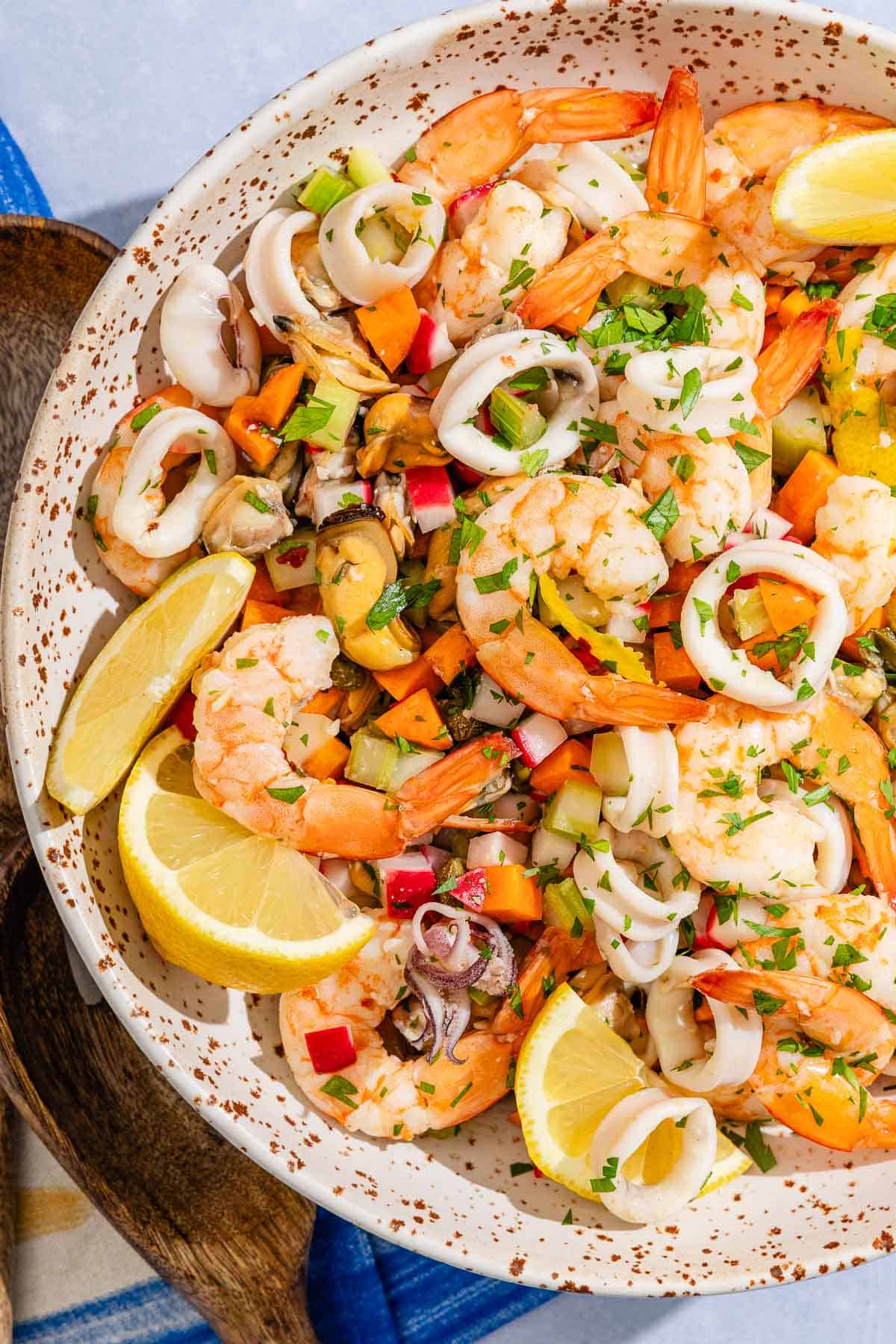
How to Make Italian Seafood Salad
You’ve done all the hard work! Now it’s time to put together the salad. Be sure to let it marinate for at least a couple of hours in the refrigerator before serving. This “resting” time really allows the flavors to come together and shine.
Cook the Seafood
- Steam the clams. First, place 2 pounds fresh live purged and scrubbed Manila or littleneck clams (about 2 dozen) in a large skillet and pour in 1/4 cup dry white wine (or seafood stock, vegetable broth, or water). Cover and set the skillet over medium-high heat. Let the clams cook for about 8 minutes, until they have all opened. Toss out any that have not opened after 10 minutes. Transfer the clams to a bowl, leaving the juices in the skillet. Let the clams cool while you cook the mussels.
- Steam the mussels. Add 1 pound fresh live scrubbed and de-beareded mussels (about 2 dozen) to the skillet along with the remaining 1/4 cup of wine and cover. Cook over medium-high heat for 5 minutes, or until all the mussels have opened. Toss out any that have not opened within 10 minutes. Using a skimmer or tongs, transfer the mussels to the bowl with the clams and let them cool briefly.
- Filter the juices. Line a fine-mesh sieve with a layer of damp paper towel and set it over a bowl. Pour the clam and mussel juices through the sieve and let them drip into the bowl. Cover and refrigerate until you make the dressing.
- Shuck the clams and mussels. With your fingers, pluck out the clams and mussels from their shells and transfer them to a clean bowl. Spoon a little of the reserved juices over the shellfish to keep them moist. Cover and refrigerate. Reserve the remaining juices—they will go into the dressing.
- Steam the shrimp. Fill a medium saucepan halfway with water and place a steamer basket inside. Make sure the bottom of the basket is above the water level. Bring the water to a boil and add 12 ounces medium to large shrimp (20 to 25) peeled and deveined to the steamer basket. Cover and steam for 5 minutes, or until the shrimp are just cooked through. Transfer them to a clean bowl.
- Poach the calamari. Remove the steaming basket from the pot of water. Add more water if needed so that there is enough to cover 12 ounces cleaned calamari rings and tentacles. Add a fresh bay leaf and a generous pinch of salt to the water, and bring to a boil. Drop in the calamari, stir to separate the pieces, and simmer for 5 to 7 minutes, or until the calimari is opaque but very tender. Take care not to overcook or they will toughen. Use a skimmer or slotted spoon to transfer the calamari to the bowl with the shrimp.
Make the Seafood Salad
- Make the dressing. With a vegetable peeler, peel off 4 strips of zest from 1 lemon—just the yellow part, no white pith—and set them aside. Squeeze the juice of the lemon into a small bowl. Whisk in 3 tablespoons of the reserved shellfish juices. Add 1/2 teaspoon salt, 1 minced garlic clove and 2 tablespoons of finely-chopped parsley and whisk it into the dressing, along with a generous pinch of crushed red pepper. Then, whisk in 1/2 to 3/4 cup of extra virgin olive oil. Use less oil for a more pronounced lemon flavor, and more for a gentler flavor. Stir in 1 tablespoon drained capers. Taste and add additional salt if needed.
- Assemble and marinate the salad. Place all of the seafood in a large bowl and pour the dressing over them. Add the reserved strips of lemon peel and toss gently. Tuck in the remaining fresh bay leaf, cover, and refrigerate the salad while you prep the quick-pickled vegetables.
- Make the pickled vegetables. Cut one large stalk of celery into small dice and place it in a heatproof bowl. Peel one carrot and cut it into thin matchstick pieces (or small dice). Add it to the bowl with the celery. Slice off the tops and bottoms of 5 radishes and cut them into small dice; add them to the bowl with the other vegetables. Combine 1/2 cup water, 1/2 cup cider or white wine vinegar, 3 tablespoons sugar, and 1/2 teaspoon salt in a small saucepan and heat on medium, stirring, until the sugar and salt are dissolved. Pour the brine over the vegetables, stirring to mix everything together. Cover and refrigerate for at least 1 hour.
- Add the vegetables. About 30 minutes before you want to serve the salad, remove the quick-pickled vegetables from the refrigerator and drain them. Remove the marinated seafood from the refrigerator and stir in the quick-pickled vegetables. Cover and return the seafood salad to the refrigerator for 30 minutes.
- Finish and serve. Spoon the seafood salad into a decorative serving bowl. Serve as an appetizer or as a light dinner, with crusty bread or bruschetta (grilled bread) on the side.
Make it Your Own
Here are some fun ways you can vary this recipe.
- Make it all calamari or all shrimp: You can simplify things by using just one seafood instead of four different types. My vote is for calamari, which has an appealing tender bite, plus visual appeal thanks to those rings and curly tentacles.
- Add more crunchy vegetables: If you would rather not take the time to quick-pickle vegetables, simply add some raw crunchy ones. Finely diced red onion and thinly sliced fennel are two of my favorite options.
- Take a shortcut: If you wanted to save a step, you could substitute a jar or a batch of already-made Giardiniera (Italian Pickled Vegetables), drained of their brine.
- Bulk it up: To make this salad a little more substantial, add in about 1 cup cooked chickpeas. Chickpeas add texture and an earthy flavor that pairs well with this lemony salad. Or, toss in 1/2 cup of briny green olives for another assertive, complementary pairing.
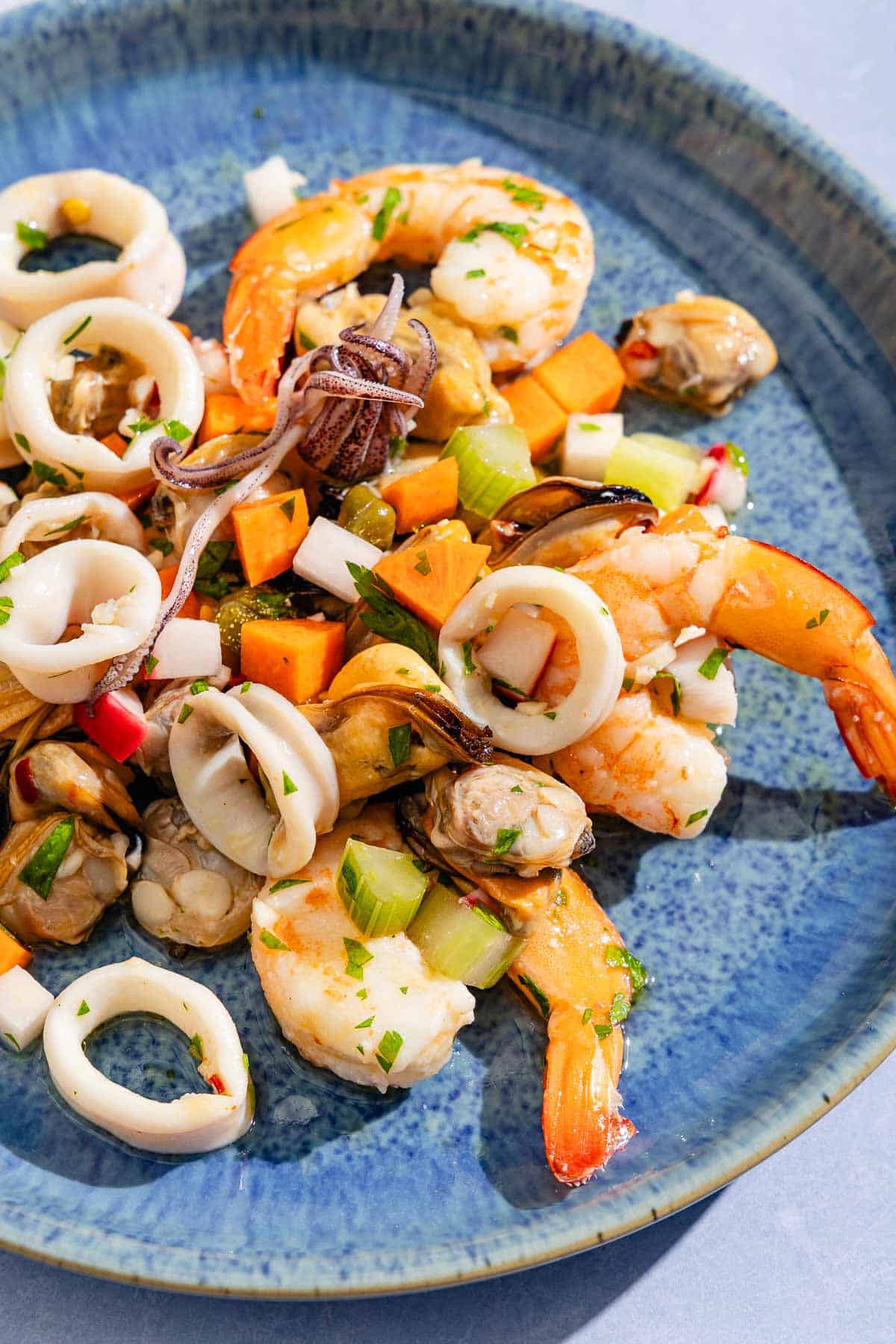
What to Serve with Italian Seafood Salad
Whether I’m serving insalata di mare as an antipasto or as a light entrée, I always accompany it with good bread or slices of garlic bread to soak up the dressing and seafood juices.
Or try our blistered tomato bruschetta. Another great option is to serve the seafood salad as a starter for these hearty stuffed artichokes. I also love serving this salad followed by spanakopita (Greek spinach pie).
More Mediterranean Shellfish Recipes
Appetizer and Mezze
Poached Shrimp in a Saffron and White Wine Sauce
Fish and Seafood
Shrimp Salad
Fish and Seafood
Mediterranean-Style Steamed Clams Recipe
Browse all Mediterranean recipes.
Visit Our Shop.
Italian Seafood Salad (Insalada di Mare)

Ingredients
For the Seafood Salad:
- 1/2 cup dry white wine, seafood stock, vegetable broth, or water, divided
- 2 pounds fresh live Manila or littleneck clams (about 2 dozen), purged and scrubbed
- 1 pound fresh live mussels (about 2 dozen), scrubbed and de-bearded if necessary
- 3/4 pound medium to large shrimp (20 to 25), peeled and deveined
- 3/4 pound cleaned calamari a mix of sacs and tentacles; sacs cut into 1/2-inch-thick rings and bite-size pieces
- 2 bay leaves
- Salt
- 1 lemon
- 1 garlic clove, minced
- 2 tablespoons finely chopped flat-leaf parsley
- Crushed red pepper (optional)
- 1/2 to 3/4 cup extra virgin olive oil
- 1 tablespoon drained capers
For the Quick-Pickled Vegetables:
- 1 large stalk celery, diced
- 1 large carrot, diced
- 5 radishes, diced
- 1/2 cup water
- 1/2 cup cider or white wine vinegar
- 3 tablespoons sugar
- 1/2 teaspoon salt
Instructions
- Steam the clams. Into a large skillet, add 1/4 cup dry white wine (seafood stock, vegetable broth, or water) and the clams. Cover and set on medium-high heat. Let the clams cook for about 8 minutes, until they have all opened. Discard any that have not opened after 10 minutes. Transfer the clams to a bowl, leaving the juices in the skillet.
- Steam the mussels. Add the remaining 1/4 cup wine and mussels to the skillet, cover, and cook over medium-high for 5 minutes, or until all the mussels have opened. Toss out any that have not opened within 10 minutes. Using a skimmer or tongs, transfer the mussels to the bowl with the clams and let them cool briefly.
- Strain the shellfish cooking juices. Line a fine-mesh sieve with a layer of damp paper towel and set it over a bowl. Pour the clam and mussel juices through the sieve and let them drip into the bowl. Cover and refrigerate until you make the dressing.
- Shuck the clams and mussels. With your fingers, pluck out the clams and mussels from their shells and transfer them to a clean bowl. Pour a splash of the reserved shell fish juices over the shellfish to keep them moist. Cover and refrigerate.
- Steam the shrimp. Place a steamer basket inside a medium saucepan and add an inch of water. Make sure the bottom of the basket is above the water level. Bring the water to a boil and add the shrimp to the steamer basket. Cover and steam for 5 minutes, or until the shrimp are just cooked through. Transfer them to a bowl.
- Poach the calamari. Remove the steaming basket from the pot of water. Add more water to the pot if needed so that there is enough to cover the calamari. Add a fresh bay leaf and a generous pinch of salt. Bring the water to a boil and drop in the calamari, stirring to separate the pieces. Simmer gently for 5 to 7 minutes, or until the pieces are opaque but still very tender. Take care not to overcook or they will toughen. Use a skimmer or slotted spoon to transfer the calamari to the bowl with the shrimp.
- Make the dressing. With a vegetable peeler, peel off 4 strips of zest from 1 lemon—just the yellow part, no white pith—and set them aside. Squeeze the juice of the lemon into a small bowl—you’ll need 4 tablespoons total. Whisk in 3 tablespoons of the reserved shellfish juices. Add 1/2 teaspoon salt, the garlic, parsley, and crushed red pepper. Whisk in 1/2 to 3/4 cup of extra virgin olive oil. Use less oil for a more pronounced lemon flavor, and more for a gentler flavor. Stir in the capers. Taste and add additional salt if needed.
- Marinate the seafood. Place the shrimp, calamari, clams, and mussels in a large bowl and pour the dressing over them. Add the reserved strips of lemon zest and toss gently with a spoon. Tuck in remaining bay leaf, cover, and refrigerate the salad for at least 2 hours.
- Make the pickled vegetables. In a bowl, toss together the celery, carrots, and radishes. Combine the vinegar, water, sugar, and salt in a small saucepan with, and heat on medium, stirring, until the sugar and salt are dissolved and the mixture is hot but not boiling. Pour the brine over the vegetables, stirring to mix everything together. Cover and refrigerate for at least 1 hour.
- Assemble and serve the salad. About 30 minutes before you want to serve the salad, remove the quick-pickled vegetables from the refrigerator and drain them. Add the vegetables to the marinated seafood and toss well to combine. Cover and return the insalata di mare to the refrigerator for 30 more minutes. Serve cold. Store leftovers, covered, in the refrigerator for up to 24 hours.
Notes
- Shop this recipe: Visit our shop to browse quality Mediterranean ingredients including the olive oil used in this recipe.
- Why not cook the mussels and clams together? Mussels and clams have slightly different cooking times, so I steam them separately from one another. This prevents either from being over- or undercooked.
Nutrition
Bundle and Save!
Four of our best-selling signature olive oils, perfect for everyday use.




